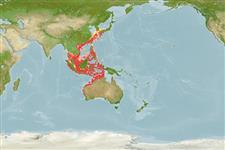Classification / Names
Common names from other countries
Main reference
Size / Weight / Age
Max length : 23.0 cm SL male/unsexed; (Ref. 188); common length : 20.0 cm SL male/unsexed; (Ref. 188)
Length at first maturity
Lm ?, range 14 - 15 cm
Environment
Marine; pelagic-neritic; oceanodromous (Ref. 51243); depth range 15 - 100 m (Ref. 12260)
Climate / Range
Tropical, preferred 28°C (Ref. 107945); 38°N - 33°S, 97°E - 134°E (Ref. 54869)
Distribution
Eastern Indian Ocean: Phuket, Thailand; southern coasts of East Java and Bali; and Western Australia. Western Pacific: Java Sea, Philippines, Hong Kong, Taiwan Island, southern Japan. Can not be distinguished as yet on morphological grounds from Sardinella aurita which occurs in the Atlantic Ocean.
Countries | FAO areas | Ecosystems | Occurrences | Introductions
Short description
Dorsal
spines
(total): 0;
Dorsal
soft rays
(total): 13-21;
Anal
spines: 0;
Anal
soft rays: 12 - 23. A faint golden spot behind gill opening, followed by a faint golden mid-lateral line; a distinct black spot at hind border of gill cover (absence of pigment). Body elongate, sub-cylindrical. Distinguished from all other clupeids in the eastern Indian Ocean and western Pacific by its pelvic fin ray count of i 8; from S. longiceps by its shorter head length and fewer lower gill rakers.
IUCN Red List Status (Ref. 115185)
Threat to humans
Harmless
Human uses
Fisheries: highly commercial
More information
ReferencesAquacultureAquaculture profileStrainsGeneticsAllele frequenciesHeritabilityDiseasesProcessingMass conversion
Tools
Special reports
Download XML
Internet sources
Estimates of some properties based on models
Phylogenetic diversity index
PD50 = 0.5000 many relatives (e.g. carps) 0.5 - 2.0 few relatives (e.g. lungfishes)
Trophic Level
2.5 ±0.00 se; Based on food items.
Resilience
High, minimum population doubling time less than 15 months (K=0.8-1.3; tmax=4.5)
Vulnerability
Low vulnerability (18 of 100)
Price category
